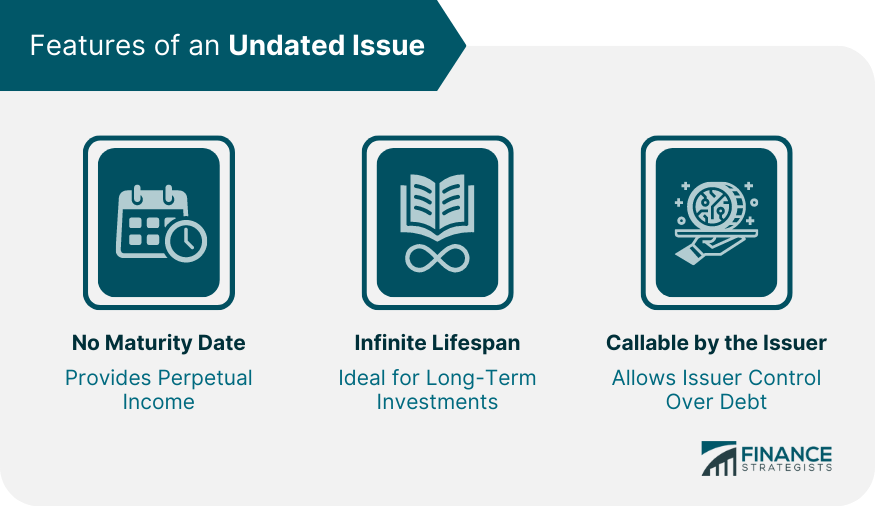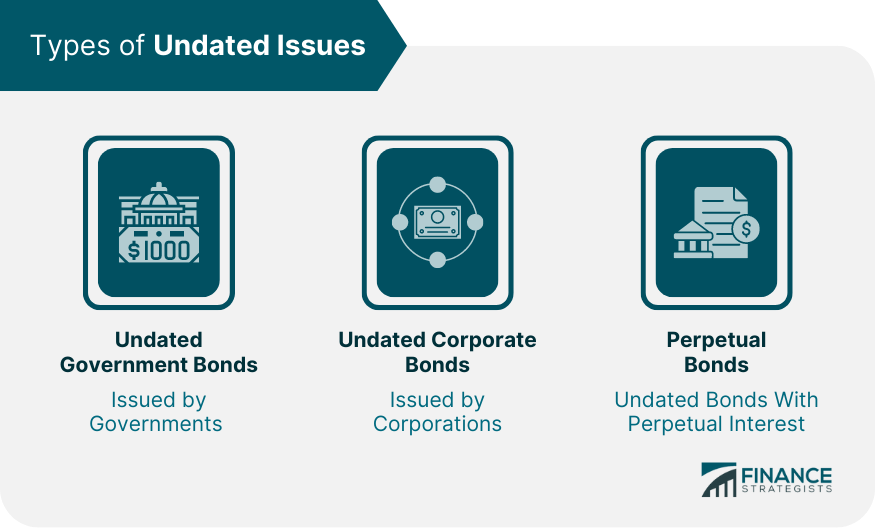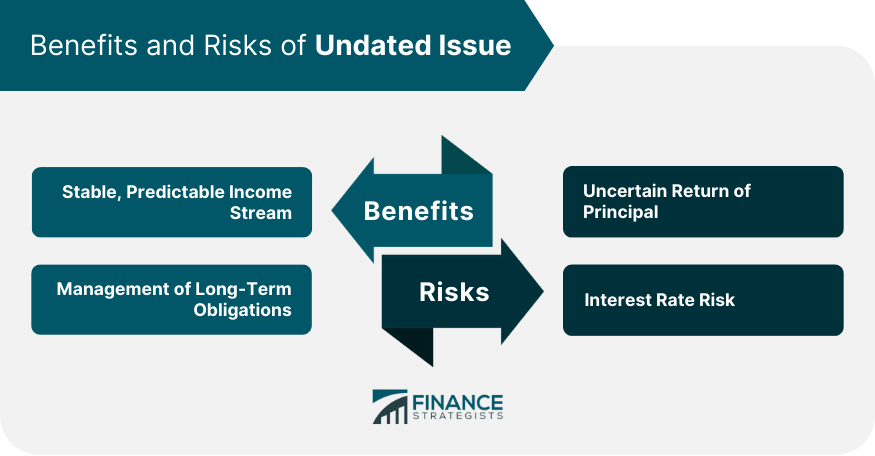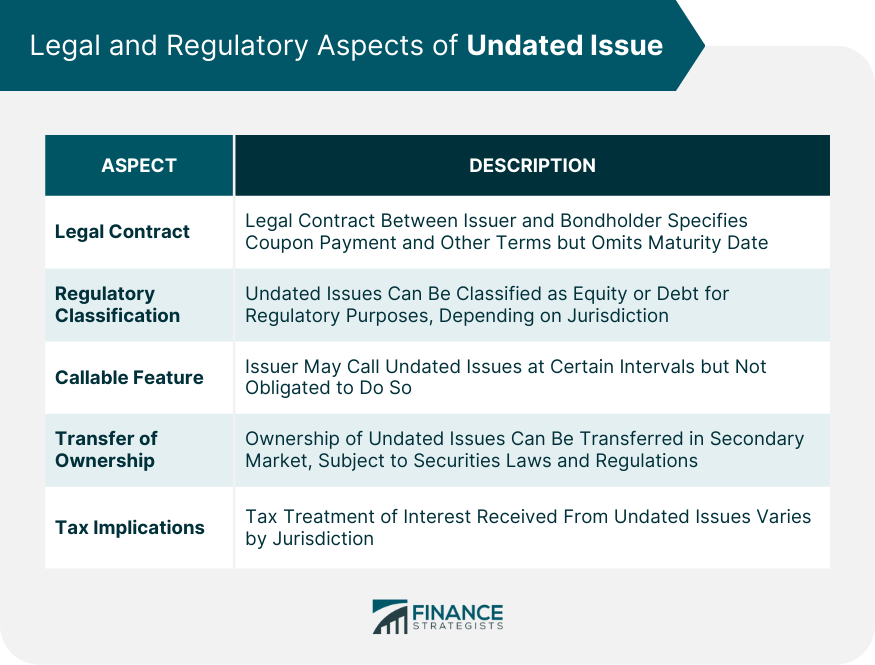An undated issue, also known as a perpetual bond or a consol, is a type of bond with no maturity date. Unlike conventional bonds repaid at a specified date, undated issues may be held forever. Interest payments continue indefinitely. Hence they can provide a consistent income stream for investors. Undated issues have existed since the 18th century, first appearing in the UK as government bonds or "consols." Their long history is a testament to their durability and attractiveness to investors seeking long-term, reliable income streams. Over time, their usage has expanded from governments to corporations, and they have become a key tool in managing long-term financial liabilities. The defining feature of an undated issue is its need for a maturity date. Unlike most bonds that return the principal amount to the holder on a pre-determined date, an undated issue can go on forever. This gives the investor a perpetual income stream through interest payments. Following from the absence of a maturity date, undated issues have an infinite lifespan. This can be attractive for investors looking for a long-term, steady investment. Although undated issues don't mature, they often include a clause allowing the issuer, whether a corporation or a government, to recall the bond at a certain price. This feature benefits the issuer, providing a level of control over its long-term debt. Undated government bonds have been a significant part of UK public debt management. An example is the "War Loan," issued by the UK government to fund World War I and II efforts. It carried an interest rate of 3.5% and was redeemed in 2015. Corporations also issue undated bonds. An example is British Telecom (BT), which issued undated bonds to manage their pension fund liabilities. These corporate bonds often carry higher interest rates than government bonds, reflecting the increased risk. A perpetual bond is another term for an undated issue. These bonds continue indefinitely, providing perpetual interest payments to investors. An example is the Dutch East India Company, which issued a perpetual bond in 1623 that's still paying interest to this day. Investing in undated issues can be attractive for individuals and institutional investors. Here are the two main benefits: Unlike equity investments, which can be volatile and unpredictable, undated issues offer a steady stream of income in the form of regular interest payments. This predictability makes undated issues appealing for those who require regular income, such as retirees or institutions with ongoing financial obligations. For issuers, undated issues offer a unique opportunity to manage their long-term financial obligations. Since the principal does not need to be repaid, issuers can raise funds without the pressure of a repayment deadline. This can be particularly beneficial for corporations managing long-term liabilities such as pension fund obligations or governments managing public debt. However, the unique characteristics of undated issues also present specific risks. These risks need to be understood and managed carefully: One of the defining characteristics of undated issues is their need for a maturity date, meaning the return of the principal is still being determined. Investors might only receive the initial investment back if the issuer decides to call the bond. This presents a risk for those who need access to their capital in the future. Like all bonds, undated issues are exposed to interest rate risk. If interest rates rise, the value of undated issues typically falls because investors can achieve a higher return elsewhere. If interest rates fall, the value of undated issues can increase. Investors need to remember this, particularly when interest rates are likely to fluctuate. Undated issues, also known as perpetual bonds, are a unique form of financial instrument that does not have a set maturity date. They carry specific legal and regulatory aspects that differentiate them from other debt securities: Legal Contract: The terms and conditions of undated issues, like all bonds, are laid out in a legal contract between the issuer and the bondholder. This contract stipulates the coupon payment and other terms of the issue but omits a maturity date. The issuer should pay the periodic interest indefinitely. Regulatory Classification: Depending on the jurisdiction, undated issues can be classified as either equity or debt for regulatory purposes. For instance, in some cases, their indefinite term may be counted as equity capital for banks under Basel III capital adequacy rules. Callable Feature: Many undated issues are callable, meaning the issuer has the right, but not the obligation, to repay the principal at certain intervals. This call feature is often included to give issuers flexibility and must be clearly stipulated in the bond's legal contract. Transfer of Ownership: Like other bonds, the ownership of undated issues can be transferred from one investor to another in the secondary market. This transaction is subject to securities laws and regulations. Tax Implications: The tax treatment of the interest received from undated issues can vary. In some jurisdictions, it may be taxed as income; in others, it could be treated as dividends. Investors and issuers must know these legal and regulatory aspects before engaging with undated issues. As always, the specific laws and regulations will depend on the jurisdiction and the exact terms of the bond. The valuation of undated issues is based on the present value of their infinite stream of cash flows. It's essentially the annual interest payment divided by the discount rate, which is the required rate of return for similar investments. Undated issues are sensitive to changes in interest rates. When rates rise, the price of existing undated issues usually drops, as newer bonds offer higher returns. Conversely, if interest rates fall, the price of existing undated issues can rise. An undated issue, or a perpetual bond, is a bond with no maturity date. It provides a constant stream of interest payments to investors, theoretically forever. Undated issues are unique financial instruments that offer numerous benefits, including a steady income stream and a tool for managing long-term debt. However, they also come with risks, such as interest rate fluctuations and the uncertainty of principal repayment. Undated issues represent an exciting niche in the fixed-income market. As with any investment, understanding the benefits, risks, and intricacies of undated issues is crucial for investors and issuers alike. If you're considering adding undated issues to your portfolio, consider consulting with a wealth management professional. They can provide guidance on how these unique financial instruments fit into your overall investment strategy.What Is an Undated Issue?
Features of an Undated Issue
No Maturity Date
Infinite Lifespan
Callable by the Issuer

Types of Undated Issues
Undated Government Bonds
Undated Corporate Bonds
Perpetual Bonds

Benefits of Undated Issue
Stable, Predictable Income Stream
Management of Long-term Obligations
Risks of Undated Issue
Uncertain Return of Principal
Interest Rate Risk

Legal and Regulatory Aspects of Undated Issue

Financial Valuation of Undated Issue
Conclusion
Undated Issue FAQs
An undated issue is a type of bond with no maturity date. These bonds can last forever, providing investors with continuous interest payments.
The primary benefit of undated issues is their ability to provide a steady income stream indefinitely. They are appealing to investors seeking long-term, stable investments.
Given their perpetual nature, the main risk is the uncertainty of principal repayment. Also, they are sensitive to interest rate fluctuations, which can impact their market value.
Both governments and corporations issue undated bonds. They serve as a tool for managing long-term financial obligations.
Undated issues are valued based on the present value of their infinite stream of cash flows. The valuation depends on the annual interest payment and the discount rate.
True Tamplin is a published author, public speaker, CEO of UpDigital, and founder of Finance Strategists.
True is a Certified Educator in Personal Finance (CEPF®), author of The Handy Financial Ratios Guide, a member of the Society for Advancing Business Editing and Writing, contributes to his financial education site, Finance Strategists, and has spoken to various financial communities such as the CFA Institute, as well as university students like his Alma mater, Biola University, where he received a bachelor of science in business and data analytics.
To learn more about True, visit his personal website or view his author profiles on Amazon, Nasdaq and Forbes.















